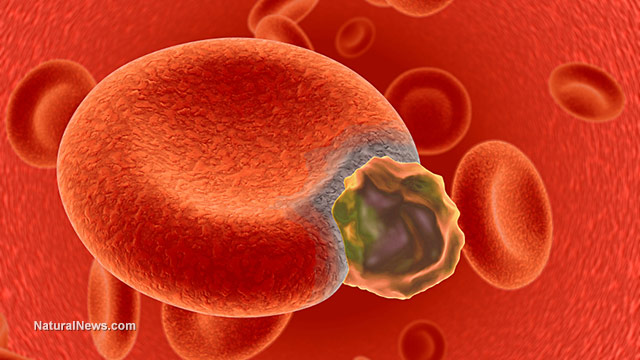Researchers find 'interactions' between cancer cells and their environment
Friday, December 02, 2016 by: J. D. Heyes
Tags: cancer treatment, cell migration, extracellular matrix

(NaturalNews) New research indicates that there are interactions between an animal cell and its surrounding environment within a fibrous network called the extracellular matrix, and that in turn plays a vital role in how cells function, including migration and growth.
However, as Medical Xpress reports, scientists don't yet fully understand the mechanical forces that govern such interactions.
The site noted that a multidisciplinary team of engineers from Cornell University and colleagues from the University of Pennsylvania have come up with a way to measure the force a cell – in this instance a breast cancer cell – exerts on its fibrous surroundings. The researchers said that learning how to understand those forces will have huge implications for a number of disciplines, including cancer biology and immunology, and may even assist scientists with designing better biomaterial scaffolds for the engineering of tissues.
The group, led by Mingming Wu, an associate professor in the Department of Biological and Environmental Engineering, devised a technique known as 3-D traction-force microscopy to determine the displacement of fluorescent marker beads added to a collagen matrix. The engineering team said that an important component of their research was finding a way to calculate the force exerted by cells as they displaced the beads. The calculation was made by the team led by University of Pennsylvania professor of materials science and engineering, Vivek Shenoy.
'The matrix is like a rope'
The paper, "Fibrous nonlinear elasticity enables positive mechanical feedback between cells and extracellular matrices," was published online Nov. 21 in the journal, Proceedings of the National Academy of Sciences.Matthew Hall, PhD, who is now conducting post-doctoral research at the University of Michigan, is the study's lead author and the one who engineered the collagen matrices used to conduct the research.
Wu, who was also affiliated with the Cornell Center on the Microenvironment and Metastasis at Weill Cornell Medicine, which existed from 2009–2015, said that her group's work focused on a primary question: "How much force do cells exert on their extracellular matrix when they migrate?"
The answer to that question was previously unknown.
"The matrix is like a rope, and in order for the cell to move, they have to exert force on this rope," she said, as quoted by Medical Xpress. "The question arose from cancer metastasis, because if the cells don't move around, it's a benign tumor and generally not life-threatening."
The engineer groups found that it is when cancerous cells migrate that serious problems tend to occur. That's because the migration takes place via "cross-talk" between the moving cell and the matrix, they discovered. As the cell tugs on the matrix, that causes the fibrous matrix to stiffen. In turn, the increased stiffening causes the cell to pull even harder, which then stiffens the matrix even more. The increased stiffening also boosts cell force transmission distance, the teams found, which can then, potentially, promote the metastasis of the cancer cells.
New discoveries follow the development of new tools
Hall noted that the teams demonstrated that cells are "able to align the fibers" that surround them through the exertion of force. In addition, the teams showed that "when the matrix is more fibrous - less like a continuous material and more like a mesh of fibers - they're able to align the fibers" by creating more force. Once the fiber is lined up and tight, it becomes far easier for cells "to pull on them and migrate."Hall stated further that she was a big believer that each new scientific discovery generally coincides with "new technology development." She noted further that with each new tool, scientists and researchers are empowered to discover new things.
It isn't clear where the research would go from this point or whether it will have an immediate impact either on traditional cancer treatment or ongoing cancer research.
Sources:
MedicalXpress.com
Science.NaturalNews.com
Cancer treatment at FETCH.news
Get independent news alerts on natural cures, food lab tests, cannabis medicine, science, robotics, drones, privacy and more.
Take Action: Support Natural News by linking to this article from your website
Permalink to this article:
Embed article link: (copy HTML code below):
Reprinting this article:
Non-commercial use OK, cite NaturalNews.com with clickable link.
Follow Natural News on Facebook, Twitter, Google Plus, and Pinterest
- Red Cross issues warning to stop blood plasma donations from vaccinated people
- CNN runs bizarre headline proving the unvaccinated were right: The fully jabbed are “dying from Covid-19”
- The U.S. military, creator of the COVID VACCINE, already knew since 2016 that IVERMECTIN was the BEST product to use in the event of a pandemic
- PUSHED TOO FAR: Former Putin advisor says Russia has no choice but to use tactical NUCLEAR WEAPONS against NATO
- Amazon bans Dr. Paul Marik’s book on traditional, natural remedies for cancer
- Tyranny wins: Durov caves, deploys AI to “comb” Telegram users for illegal content
- Blatant democrat corruption: FCC fast-tracks approval for George Soros purchase of 200-plus U.S. radio stations in 40 markets weeks before presidential election
- RFK Jr. proposes subsidizing organic food, not Ozempic, as solution to obesity “for half the price”
- Why are Barack and Michelle Obama so closely tied to P. Diddy and many other elite rapists, sex offenders?
- Border Patrol warns that suspicious adults posing as “parents” are drugging, abducting young children to be trafficked into America
- Court dismisses wrongful death lawsuit against hospital where COVID-19 patient died after being switched from ivermectin to remdesivir
- Israel’s “exploding pagers” attack qualifies as a WAR CRIME under Geneva Conventions of 1949
- Sermon 3: Mike Adams explains the difference between MAN’S ECONOMY and GOD’S ECONOMY
- Convenient food storage solutions for easy relocation
- Garlic: Roto-rooter for the arteries?
- Failed Trump assassin Ryan Routh had list of every location where former president would be from August through October
- 23-year-old Florida woman develops blindness, autoimmune red blood cell wasting disease after doctors forced her to get three vaccine injections
- Microsoft to bring infamous nuclear plant back to life to feed POWER-HUNGRY AI data centers
- Red Cross issues warning to stop blood plasma donations from vaccinated people
- URGENT ALERT: UV laser directed energy attack alert – details on invisible, silent weaponry used to attack Trump and his supporters
- Former Big Tech exec warns of serious dangers linked to wireless technology
- FDA-approved monkeypox vaccine causes DEATH in the vaccinated and can spread to UNVACCINATED people and kill them too
- Mike Adams releases explosive new rap song, “God Is With Us”
- TROUBLE FOR KAMALA: Tim Walz now under investigation for ties to CCP
- PURE EVIL: Israel booby-trapped CHILDREN’S TOYS with explosives to kill Lebanese children
- CDC finally admits FLUORIDE is TOXIC to humans, especially babies, causing neurological damage, so why not remove it from all municipal tap water right away?
- Globalists throwing everything they have into trying to silence free speech worldwide (but it won’t work)
- INSANE COVID COURT convicts Austrian woman of "grossly negligent homicide" for "fatally infecting her neighbor with COVID-19"
- Hillary Clinton calls for criminal arrest of anyone who speaks against NATO, U.S. empire
- Entire board of 23andMe RESIGNS, leaving only Anne Wojcicki, deceased former YouTube CEO Susan Wojcicki’s sister at helm
- CNN runs bizarre headline proving the unvaccinated were right: The fully jabbed are “dying from Covid-19”
- Bill Gates launches new Netflix series that lays out mass suicide plan for global human depopulation
- Bulgaria - not Hungary - manufactured the pager bombs used in Israel attack against Hezbollah that left 37 dead, injured thousands
- Lebanon warns of “doomsday” response for West, Asia and Europe if Israel expands war
- RFK Jr. says DOJ under Trump will launch RICO investigations into collusion between medical boards, medical journals and Big Pharma
- Sunlight and clouds, not CO2, responsible for planetary climate changes
- Red Cross issues warning to stop blood plasma donations from vaccinated people
- Cancer researcher: IVERMECTIN can overcome chemotherapy resistance of TURBO CANCERS caused by mRNA vaccines
- Most of today's vaccines are developed with ABORTED FETAL CELL LINES – Here's the full list
- Christian churches that advocate for Israel’s mass killing of Palestinian civilians are serving SATAN, not Christ
- GLOBAL EMERGENCY UNFOLDING: Japan will unleash Bill Gates-approved, SELF-REPLICATING mRNA vaccines starting next month
- Haitian migrants demonstrate remarkable food survival skills – Americans, take note
- URGENT ALERT: UV laser directed energy attack alert – details on invisible, silent weaponry used to attack Trump and his supporters
- Dr. Sabine Hazan reveals that important gut bacteria are ERASED by COVID “vaccines”
- WEF admits COVID was a “test” of public obedience to new globalist world order
- More horrifying details emerge about the 20,000 Haitian migrants INVADING Springfield, Ohio: Residents are fleeing due to overwhelming VIOLENCE
- The migrant gang takeover of apartment buildings in Aurora, Colorado is just a small taste of the chaos to be unleashed against Americans
- UN and WHO coordinate massive POLIO vaccine experiment on 640,000 displaced Palestinian children
- The “public health” agenda of US regulators and pharmaceutical companies is actually a PUBLIC DEATH agenda
- DEAD HUMANS LIQUEFIED, then fed back to the population via fertilizer on crops
- U.S. Navy sailors CRIPPLED by COVID jabs - 17 support ships to be SIDELINED due to “post-COVID manpower issues”
- Ivermectin outperforms chemo in breast cancer treatment, study finds
- Dr. Malone explains how COVID-19 vaccines cause cancer in latest congressional hearing discussing vaccine injuries
- Bill Gates launches new Netflix series that lays out mass suicide plan for global human depopulation
- Red Cross issues warning to stop blood plasma donations from vaccinated people
- Heavily CENSORED Pfizer documents show that COVID began a five-year mass DEPOPULATION agenda that will reach completion by 2025
- 5G REMOTE KILL VECTOR: Science paper reveals cell phone signals can activate the release of biological PAYLOADS from graphene oxide injected into the body
- DATA: England’s vaccinated population had close to one million deaths in 23 months; unvaccinated population had less than 61,000 deaths over the same period
- New $4B Panasonic electric vehicle (EV) battery factory in Kansas requires so much power that the facility will need its own COAL plant to run
- Arizona residents drive entire Maricopa County Board of Supervisors out of meeting after serving them for TREASON
- Anonymous airline pilot exposes chemtrail operation in the U.K.
- Moderna admits mRNA COVID jab causes CANCER, billions of DNA fragments found in vials
- People who got COVID jabbed now displaying major personality changes stemming from vaccine-induced neurological damage, experts warn
- SOURCES: Jamie Foxx was forced against his will to get covid jabbed for movie, then developed debilitating blood clot in his brain
- Scientists confirm: GENIUS brain function can be spontaneously unleashed in humans without any apparent cause
- Today I asked our AI language model “Neo” about which phytonutrients or phytochemicals can block the spike protein related to SARS-CoV-2 … Here is what it answered…
- Study: TikTok trend of hotwiring certain car models linked to surge in car thefts in U.S. cities
- Fully vaccinated about to see “tsunami” of illness and death, warns virologist
- Full-scale medical martial law coming to America in 2024
- Natural News issues statement on Hamas terror attack on Israel, bombings of Gaza, ethnic cleansing vs humanitarian principles
- Former Bill Gates vaccine scientist predicts sharp population decline: “up to 30-40% in highly vaccinated countries”
- BREAKING: 2025 NDAA authorizes mandatory military draft of WOMEN across America… as Pentagon pursues global NUCLEAR war with both Russia and China at the same time
Science News & Studies
Medicine News and Information
Food News & Studies
Health News & Studies
Herbs News & Information
Pollution News & Studies
Cancer News & Studies
Climate News & Studies
Survival News & Information
Gear News & Information
News covering technology, stocks, hackers, and more



"Big Tech and mainstream media are constantly trying to silence the independent voices that dare to bring you the truth about toxic food ingredients, dangerous medications and the failed, fraudulent science of the profit-driven medical establishment.
Email is one of the best ways to make sure you stay informed, without the censorship of the tech giants (Google, Apple, Facebook, Twitter, YouTube, etc.). Stay informed and you'll even likely learn information that may help save your own life."
–The Health Ranger, Mike Adams























